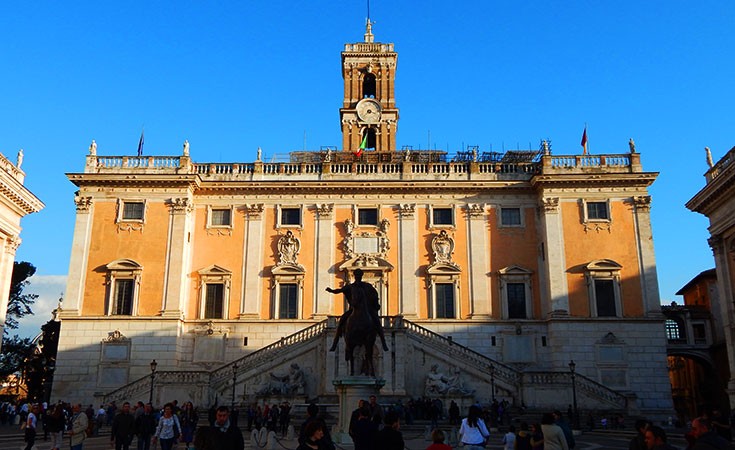
Capitoline Hill in Rome is one of the famous hills of the city, which history is intertwined with the history of Roman Empire and its most famous events. Therefore, the story of this famous hill will amaze you, while its modern look will impress you. Every story about this hills is at the same time a historical fact which brings alive an era and thus definitely worth reading.
Capitol, that is located between the Forum and the field of Mars, is one of the seven hills of Rome on which ancient Rome was founded. According to the wish of the fifth Roman king Tarquinius (Lucius Tarquinius Superbus, ruled between 617-579 BC) the temple dedicated to Jupiter, his wife Juno and their daughter Minerva (the gods in Roman mythology) was constructed on this hill. For a long time this temple was considered to be the largest and the most beautiful in the city. Brut and his accomplice locked themselves exactly here after they had killed Julius Caesar. In 69 AD, Vespasian’s brother and nephew were besieged in the temple. This year in history is known as the year of four kings, because the last emperor of the Julio-Claudio family - Nero, committed suicide and left Rome without a ruler. The suicide of Nero was followed by a civil war between four claimants to the throne, from which Vespasian came out as the winner and founded his own dynasty.
Capitol is considered to be the place of famous events in the history of Ancient Rome. According to some sources, Vestal Virgin Tarapeia opened the gates of the city to the Sabine tribe (the tribe that lived in the central Apennines) returning for the golden bracelets that the members of the tribe carried on their left arms. After Sabine entered the city, the members of the tribe with their leader Tito Tazio honored their agreement by throwing their bracelets and heavy shields on the virgin which led to her death. Vestal virgin Tarapeia was buried next to the cliff on the Capitol Hill that carries her name today. Later, all those considered to be traitors of Rome were thrown off this cliff.
In 83 BC, a fire broke out destroying Capitol Hill together with a famous temple dedicated to Jupiter. In 78 BC, renovation works began during which the state archive (Tabularium) was rebuilt, while the whole reconstruction process ended in 69 BC.
On top of Capitol Hill, Octavian August (the first Roman imperator), built a temple dedicated to Mars, the avenger (Roman god of war). Every January people of Rome used to bring gifts to this place, mostly out of fear and respect, even when August was out of Rome. August used these funds for building different statues of Gods dedicated to Apollo, Jupiter etc.
In 69 AD, when Vespasian was fighting for power, his army caused a huge fire that devoured Capitol. But in the same year, after he was declared the ruler of Rome, he ordered the complete restoration of the buildings on this hill. In 75 AD, the temple dedicated to Jupiter was reopened. In 80 AD, another fire broke out, followed by another restoration that was completed during the reign of Domitian in 81 AD. Hadrian and Marco Aurelius further decorated the whole hilltop.
A famous Renaissance artist Michelangelo is responsible for the modern look of this well-known hill. Pope Paolo III chose him to redesign the whole Capitol, since he wanted to present Capitol as the new symbol of Rome to King Charles V, whose arrival was expected in 1538. Also, two new buildings were constructed - Palazzo dei Conservatori (built on top of the Jupiter’s temple) and Palazzo Nuovo. Nowadays, these two building are the Capitoline Museums.
According to Michelangelo’s design, three buildings would be placed on the hill forming a trapezoid. He designed special stairs called Cordonata that led to the hill. He was also responsible for closing up the view towards the Roman Forum and redirecting it towards the Saint Peter’s Cathedral (Christian symbol of the city). On the middle of the Capitol square, there is a statue of Marco Aurelio (Roman imperator that ascended the throne in 161 AD). The church believed that this was the statue of Imperator Constantine, who allowed Christianity to become the dominant religion in the empire – this is why the statue managed to survive on this square for such a long time during the Middle Ages.
Michelangelo also designed the whole square, which was supposed to have the shape of a twelve-pointed star in correlation with constellations, while the center of it would represent Caput mundi (the head of the world). However, popes never supported this solution, believing that there were hidden symbols behind Michelangelo’s design. Finally, in 1940, Benito Mussolini ordered this square to be built according to the original Michelangelo’s design.
Interesting facts